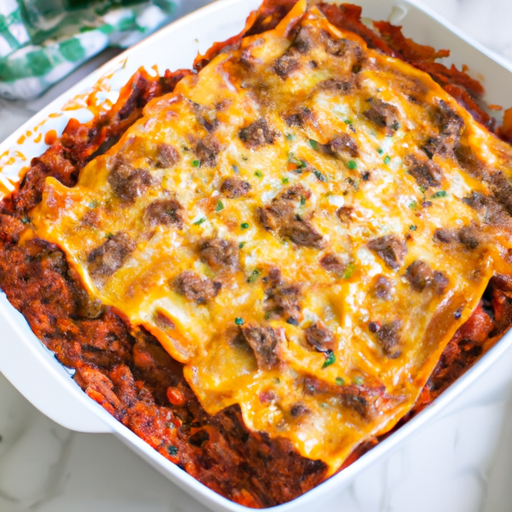Broccoli and Spring Onion Mac ‘n’ Cheese
A comprehensive exploration of broccoli and spring onion mac ‘n’ cheese is presented.
Its history, ingredients, instructions, cooking tips, and final thoughts will be discussed in detail.
Writing with an academic style of objectivity and impersonality, readers are provided with descriptive and informative content that engages their interest.
Broccoli and Spring Onion Mac ‘n’ Cheese History
The history of broccoli and spring onion mac ‘n’ cheese can be traced back to its origins in American cuisine during the 20th century.
Macaroni and cheese, a beloved comfort food made with macaroni pasta and melted cheese, has been savored in various forms since the late 18th century. The dish became widely popular during the early 1900s, when processed foods were becoming more readily available.
The addition of broccoli and spring onions to classic mac ‘n’ cheese may have been intended to add a nutritional boost as well as a delicious flavor to the dish.
Nowadays, this variation remains a favorite amongst those looking for a fulfilling meal that pairs creamy cheese sauce with fresh veggies.
Ingredients for Broccoli and Spring Onion Mac ‘n’ Cheese History
- 2 cups cooked macaroni
- 2 cups shredded cheddar cheese
- 1 cup cooked broccoli florets
- 1/4 cup chopped fresh spring onion
- 2 tablespoons butter
- 2 tablespoons all-purpose flour
- 1 cup milk
- 1/2 teaspoon Dijon mustard
- 1/4 teaspoon garlic powder
- Salt and pepper to taste
Instructions
Combining a cruciferous vegetable, a green onion-like plant, and pasta with cheesy sauce creates a flavorful and indulgent mac ‘n’ cheese dish. The following instructions will guide you through the process of making this delicious meal:
-
Cook the pasta:
Bring a large pot of salted water to a boil and cook the pasta according to package instructions until al dente. Drain and set aside. -
Prepare the vegetables:
Chop the broccoli into small florets and thinly slice the spring onions. -
Make the cheesy sauce:
In a separate saucepan, melt butter over medium heat. Add flour and whisk continuously for about 2 minutes to create a roux. Gradually pour in milk while whisking constantly until smooth and thickened. Stir in grated cheese until melted and season with salt and pepper. -
Combine everything:
Add cooked pasta, chopped broccoli, and sliced spring onions to the cheese sauce. Mix well until everything is coated evenly. -
Serve hot:
Transfer the mac ‘n’ cheese into individual bowls or onto plates, garnish with additional grated cheese if desired, and tuck in!
Cooking Tips for Broccoli and Spring Onion Mac ‘n’ Cheese
Cooking tips can enhance the preparation of a flavorful and indulgent dish that combines cruciferous vegetables, green onion-like plants, and pasta with cheesy sauce. To make the perfect broccoli and spring onion mac ‘n’ cheese, use the following tips:
-
Blanch broccoli for vibrant color: Cooking broccoli briefly in boiling water before adding it to the mac ‘n’ cheese ensures it is cooked through but still retains its vibrant green color and crunch.
-
Sauté spring onions for flavor: Sautéing the spring onions in butter or oil brings out their sweet flavor and adds a delightful aroma to the dish.
-
Choose sharp cheddar & Gruyere or Parmesan cheeses: Opt for a combination of sharp cheddar and creamy Gruyere or Parmesan cheeses to create a rich, gooey sauce that complements the vegetables and pasta perfectly.
-
Top with breadcrumbs for crunch: Sprinkle breadcrumbs on top before baking to create a crispy golden crust that contrasts with the creamy mac ‘n’ cheese underneath.
Final Thoughts
At the end, following these culinary tips can lead to a delectable dish that highlights the perfect blend of vegetables, pasta, and creamy cheese sauce.
Broccoli and spring onion contribute an energizing touch to the mac ‘n’ cheese, providing both color and flavor. The broccoli brings a slight bitterness to balance out the richness of the cheese sauce, while the spring onions offer a slight sweetness.
Not only do these ingredients enhance the taste, but they also offer nutritional value, as they are full of essential vitamins and minerals.
The pasta provides a comforting foundation for this dish, making sure each bite is satisfyingly fulfilling.
Lastly, the creamy cheese sauce ties everything together with its velvety texture and scrumptious taste.
All in all, this broccoli and spring onion mac ‘n’ cheese delivers an enjoyable experience for both the taste buds and senses.
Frequently Asked Questions
Can I Substitute the Broccoli With Another Vegetable in This Recipe?
Substituting broccoli with another vegetable in the recipe of Broccoli and Spring Onion Mac ‘n’ Cheese is a possibility. However, it is important to consider the taste, texture, and cooking time of the chosen vegetable for optimal results.
How Many Servings Does This Recipe Typically Yield?
The typical yield of servings for the recipe in question can vary depending on portion sizes. However, a standard estimate would be to expect around 4-6 servings based on the ingredients and quantities listed.
Can I Use Regular Onions Instead of Spring Onions?
The use of regular onions as a substitute for spring onions in recipes is common and can provide a similar flavor profile. However, it is important to consider the specific taste and texture requirements of the dish at hand.
Can I Use a Different Type of Cheese in This Recipe?
In considering variations for the cheese used in this recipe, it is important to note that different types of cheese can significantly alter the taste and texture. Experimentation with alternative cheeses may yield interesting results, but careful consideration should be given to compatibility with the other ingredients.
Can I Make This Recipe Ahead of Time and Reheat It Later?
Yes, it is possible to make this recipe ahead of time and reheat it later. This allows for convenient meal preparation and storage. However, the quality and texture of the dish may be affected upon reheating, so adjustments may be needed.






